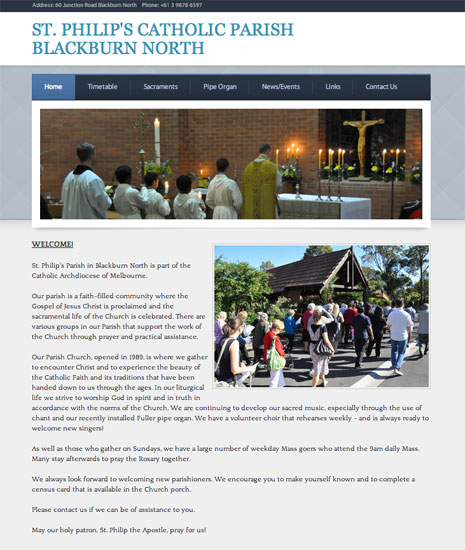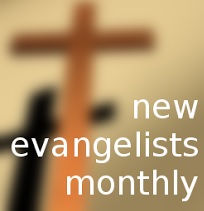The summer edition of the ACCC’s The Priest included an article by me, providing readers a how-to set up a parish website. Only six months later, I think it’s out of date!
In my discussion of which software package to use, I recommended WordPress and Joomla!
WordPress is versatile and easy to use, and Elegant Themes provides beautiful looking templates at a very low price. By way of example, I designed this blog using an Elegant Theme template. And St Mary’s Hamilton, and St Mary’s West Melbourne, and the Australian Confraternity of Catholic Clergy. If you follow those links, you can see that the “look” of each website is quite distinct and (I think) attractive!
Joomla! is even more versatile. Matthew Price, who is an accomplished web designer (and my webhosting “landlord”), swears by it. By way of example, Matt used Joomla! to build websites as varying as Corpus Christi College, the Diocese of Sandhurst, and My Family My Faith. I used to use Joomla! myself, but I have found that it’s easier to train volunteers in WordPress.
As a rule, I recommend Joomla! for the more tech-savvy. And I recommend WordPress for DIY websites. But now I need to add a third option to the suite.
This week, I received an e-mail from the parish priest of St Philip’s in Blackburn North. He wanted advice on “the best options for creating a simple, free parish website.”
I just want something that has basic information about the parish, a few pictures and ease of use.
Having considered these criteria, I spontaneously recommended Weebly. I’ve never used Weebly in my life. Nor do I plan to. But I have no reason to doubt the claims it makes in this video. Basically, it’s the easiest, drag-and-drop, no-technical-skills-required way to build a free website:
I e-mailed my recommendation shortly before 1pm. Some time after 4pm, Fr Dillon replied with thanks, and a link to the new website! He modestly called it, “a work in progress with some aspects still to be refined.” That may be so, but I’m still amazed at what could be done in the space of a few hours.
So there you have it. If you want a low-hassle, no-cost website, Weebly may be the way to go.
On the other hand, you may still require a professional website by the likes of Matthew Price, whom I recommend. Websites like his take time to develop. A Weebly site might be also prove ideal in your case, as a temporary “parking space.”
NB. A reader has reminded me “you get what you pay for.” Fr Adrian Sharp, for example, was last week embarrassed by advertising, which he himself could not see, appearing on his blog. He was using the no-cost WordPress.com service, which recently introduced advertising to pay for its “free service.” To remove the advertising, Fr Adrian upgraded to a paid level of service.
Weebly.com does not, at present, sell advertising space on its “free sites.” But there’s a distinct possibility of that happening. Users need to be alert to that. It’s always advisable, I think, to incorporate an expense budget into any medium-term web strategy. As another saying goes, “there is no such thing as a free lunch.”







I use Weebly for all my sites, such as this http://www.catholic-counselling.com although I have a paid-for ‘professional’ account. After experimenting with half a dozen builders I highly recommend it. I am not at all surprised at Fr Dillon’s experience – Weebly really is that good, that easy. It even has luddite me playing with code (if Fr Dillon has any Weebly questions tell him to shoot me an email – matthew.counsellor@outlook.com ). I moved to Weebly because Webs, which is more dynamic in its design abilities, was so unstable – I was constantly repairing new faults. And Wix, though perhaps more dynamic, requires more know-how than the very paint-by-numbers Weebly. The draw back to Weebly is that it is less dynanic, with a tiled background when any page gets long, and more rigid templates unlike say Webs where you can drag items around the page to position them exactly as you want.
Weebly does produce easy to use free websites, but it doesn’t tell you much about how much it costs to upgrade to extra features. The charge to remove the weebly from the domain name is considerably more expensive than purchasing a domain name from another source. To get decent stats on website hits you have to upgrade to the professional level.
Thank you Catherine for that absolutely useless comment.
Good point Catherine.
I can start up a WordPress or Joomla website, with its own dedicated domain name, for as little as $10.
The catch with many “free” services is that you’re locked in to their service. A Weebly site, for example, must be hosted by Weebly, so the pricing options are limited.
Any of the free services, WordPress, Weebly, Wix and others, all have their pros and cons. However, long term a professional looking website and domain name will always bring greater results. Although each of the above do have ‘upgrade packages’ they will never compare to the flexibility or development and features that can be obtained with a Joomla website. A Joomla website can also be moved across website hosting providers very easily so that you are not ‘locked in’ to the same provider. However, I would not encourage any website to be developed by someone that does not have advanced knowledge and experience if it is not being hosted within a secure environment. I always go by ‘you get what you pay for’ in all of my purchasing decisions.